“Just the idea of having these species back is already having an impact”
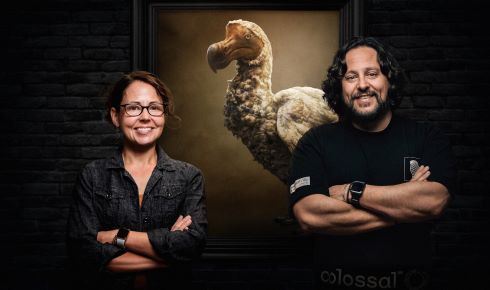
Beth Shapiro with Colossal co-founder and CEO Ben Lamm
Beth Shapiro, chief scientist at the de-extinction start-up Colossal, talks to Tom Ireland about the science and ethics of recreating long-lost species in a lab
Professor Beth Shapiro is an evolutionary molecular biologist specialising in ancient DNA. She recently took leave from her academic position at the UC Santa Cruz Genomics Institute to become chief scientist at Colossal Laboratories and Biosciences, a start-up focused on developing technologies to bring back extinct animals. The company has said it aims to create a woolly mammoth by 2027, and has also started working on resurrecting the thylacine (an extinct dog-like marsupia) and the dodo.
Earlier this year, Colossal announced it had produced induced pluripotent stem cells from elephants for the first time, which it says is a massive step forward for their work and for work to understand and conserve elephants. This month, the company announced that its latest reconstruction of a thylacine genome is the most complete and contiguous ancient genome of any species to date. Assembled to the level of chromosomes, the genome is estimated to be >99.9% accurate.
On a recent visit to the UK, Shapiro sat down with The Biologist’s editor Tom Ireland to discuss the vast range of scientific work required to bring the company’s vision to fruition – from gene-edited embryos to artificial wombs and new habitats – and whether the creatures they are creating are really what they say they are.
Hi Beth. In your 2015 book, How to Clone a Mammoth, you seemed sympathetic to many of the concerns people had about de-extinction. Yet now you're leading the science to make it happen! Can you summarise your views on why you think this is worth doing?
I understand that when people hear about de extinction, they imagine that we're bringing back an identical copy of something that used to be alive, which is impossible, as I laid out in the book. You cannot create something that is 100% identical – genetically, physiologically, behaviourally – to something that is extinct. What we can do is take a species that's alive today and gradually tweak its genome until it expresses the genetic, physiological and behavioural traits of a species that used to be around.
Where I see the great benefit of this is in helping species that are still alive to avoid the same fate of the species that are extinct. What I like about Colossal’s mission is they have a mammoth, a thylacine and a dodo; a placental mammal, a marsupial mammal and a bird. So we've got quite a lot of the animal tree of life there, and for each one, there’s a different suite of technical, ethical and ecological hurdles that need to be overcome. We write down all the challenges we need to solve, and we can knock them off one at a time. And as we do that, those technologies become immediately applicable to the protection of endangered species.
For example, at the moment we don't know how to drive gene edits in bird species other than in chickens. As we develop technologies, we can use them to help birds across the planet. For example, Hawaiian honeycreepers are at risk of becoming extinct because of avian malaria. If we could tweak their genomes so they’re not susceptible to avian malaria, they’d have a fighting chance at survival. This is really where the motivation for this comes in. Colossal recently announced the founding of the Colossal Foundation, with a $50 million starting fund to explicitly point these technologies toward the conservation of living species.
People often look at the money we’re raising [Colossal has raised at least $225 million since launch in 2021] and say ‘wouldn’t it be better spent elsewhere?’ This is not taking money away from traditional conservation. It’s new money, new investment into developing tools for biodiversity conservation, and we should be celebrating that.
In a lot of Colossal’s publicity, the creature being ‘resurrected’ is described as a woolly mammoth. But, as you said, it's impossible to resurrect a woolly mammoth. Is it misleading to call them that, when you're actually using mammoth DNA to create cold-adapted elephants? Isn’t it important to distinguish these two different animals?
I don't think it's important. Scientifically, what is a species? We don't actually know. As humans, we have a proclivity to put things in boxes, and this is the biological species concept. Biology is messy, and what we choose to call something is very individual-specific. I don't care what they're going to call it. And what Ben [Lamm, co-founder and CEO of Colossal] says to justify what he puts on the website, is that if a normal person looks at it, are they going to say it's an Arctic-adapted elephant, or are they going to say it's a mammoth? Because it's the same thing.
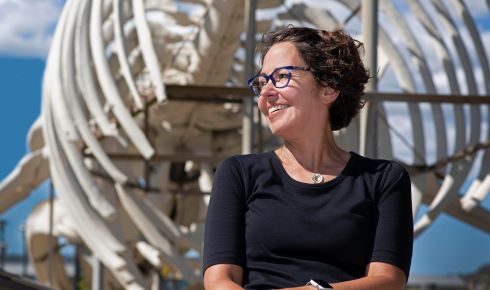 With a background in ancient DNA, Beth Shapiro has taken leave from her role as a professor at UC Santa Cruz to lead the scientific programme at Colossal
With a background in ancient DNA, Beth Shapiro has taken leave from her role as a professor at UC Santa Cruz to lead the scientific programme at Colossal
Can you tell me about your background in ancient DNA and how your specialism and interest has helped progress deextinction efforts so far?
I've always been interested in geology, palaeontology, and evolution. Being a scientist that studies the past is like being a modern day explorer. We can go to the middle of a lake and drill a core, pull up a big plug of mud and use DNA to reconstruct changes in the entire ecosystem, which sat in that place for tens or hundreds of thousands, even millions of years. We can ask questions about what makes some communities and ecosystems more resilient in the face of perturbation to their habitats or perturbation to the local climate, then hopefully be able to use that information to make more informed decisions about how to protect and preserve ecosystems today.
We’ve done all sorts of cool things, like pushing back the time limit for DNA survival and developing tools to be able to do population genetics over space and time. But we’d talk to the media about how we can apply lessons from the past to make informed conservation decisions for the future, and all they really wanted to know was how close we were to bringing mammoths back to life. I think since Michael Crichton wrote Jurassic Park, people just can't help but think about it.
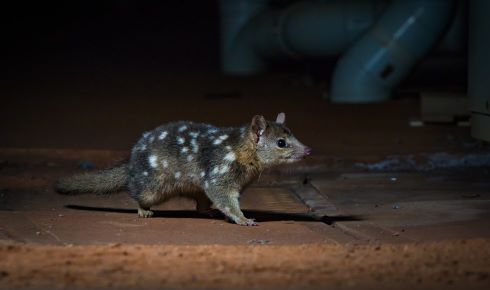 Colossal has teamed up with the University of Melbourne to help protect Australia’s endangered northern quoll (Dasyurus hallucatus, above) from the invasive cane toad. The two organisations have used CRISPR gene editing to introduce genes for resistance to cane toad toxins, found in other species, into marsupial cells.
Colossal has teamed up with the University of Melbourne to help protect Australia’s endangered northern quoll (Dasyurus hallucatus, above) from the invasive cane toad. The two organisations have used CRISPR gene editing to introduce genes for resistance to cane toad toxins, found in other species, into marsupial cells.
How degraded is the DNA that you're working with? What steps are required to recover it and piece it together?
Once an organism dies, the DNA starts getting chopped up into smaller and smaller fragments until eventually there's nothing left. The amount of time that takes depends on where that organism dies and how the remains are preserved. So in colder places, salty places and places with temperature stability, it tends to decay more slowly.
With ancient DNA, from the bones and remains we're getting from the Arctic, the fragments tend to be in the region of 30 to 100 bases long. Prior to next generation sequencing, in the early 2000s, you had to target specific fragments of DNA using PCR. You had to know exactly what you wanted to sequence and design specific primers, and they tended to need to be at least 150 bases long. Next generation sequencing, which no longer requires these primers, means we can sequence things that are really short.
A more modern example is hair. Until recently, it was thought there was no DNA in hair. Well, it turns out there's tons of DNA in hair, it's just all degraded to around 60 base pairs.
We do have a lower limit, after which they're too short to be mapped to a reference genome, and that's around 30 bases, but anything bigger can be used. We can go into Siberia or Alaska and the Yukon, wherever we can get mammoth bones, and as long as we can get DNA out of them, the whole genome is there – it's just broken up into tiny fragments.
It’s like putting together a puzzle. We have this big soup of ancient DNA, with billions of puzzle pieces that are different sizes, and the pattern we’re following is slightly different from what we're trying to put together, it’s an Asian elephant. And some of the pieces will be from microbial species or fungal species that have got into the bone.
Computationally, you can take these puzzle pieces one at a time, and figure out where they go along the genome, until you can build up the whole genome. We now have 50 to 100 high quality (depending on what you're willing to accept as high quality) mammoth genomes, but we could generate more.
If we want to figure out what it is that makes a mammoth different from an elephant, we look for places in those genomes where all of the mammoths are the same as each other, but different from the elephant.
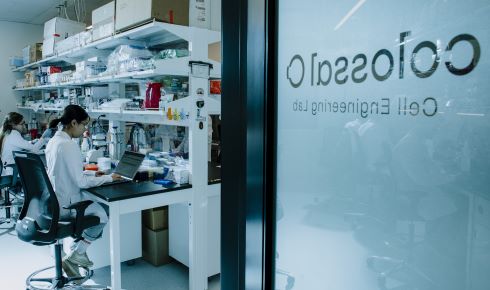 Launched in 2021, Colossal has around 100 scientists working on a range of ambitious biotechnologies for conservation and de-extinction.
Launched in 2021, Colossal has around 100 scientists working on a range of ambitious biotechnologies for conservation and de-extinction.
How different are the mammoth and the Asian elephant genetically, and how have you decided which genes to transfer from the mammoth to your hybrid embryos?
They're probably less than 1% diverged from each other. We're focusing initially on genes that are linked to things like cold tolerance, thicker layers of hair, thicker layers of subcutaneous fat, anything that's involved in tusk and tooth formation, really targeting what we describe as key phenotypes for a mammoth. We're looking for things like changes that are predicted to impact the function of those genes, or changes in promoter or enhancer regions that are predicted by software.
One of the many fascinating things in the suite of technologies that will be required for de-extinction is the artificial womb. Although there are groups working on artificial wombs for premature babies, there are many who think the idea of a fully artificial womb, which takes an organism from embryo to birth, is just impossible with existing understanding and technology.
Everything is impossible until somebody does it! As you say, there's the team from Pennsylvania with the lambs in a biobag, and there are people keeping embryos alive for longer – it's really just the bit in the middle that people haven't figured out yet. And if we can solve this problem by hiring smart people – we have scientists who focus on placentation and embryology working on that project – if we could solve it, or even push it a little bit further than we already have, that's tremendous, both for assistive reproductive technologies, for conservation projects and for human health. Sure, it's hard, but why not try to solve it?
The biobag devices are really just miniature heart-lung machines for premature animals – they are not designed to guide an embryo through its development to full term. Can you tell me a little bit more about what Colossal’s artificial wombs will look like, how they will work?
I think it will just have to evolve as we get there. Right now we’re working on something much smaller than an elephant, starting with mice and dunnarts. We have several different prototypes that look quite different from each other and we’re exploring scientifically what is going to be the best approach to get us to that stage. It could be that there's multiple devices we need throughout that term and we have to figure out how to move from one to the other. But this is all for the scientists to figure out as we try to push this technology into the future.
Can you tell me more about the team of scientists and engineers Colossal has?
I don't know the exact number of scientists that are employed at Colossal right now, but it's in the order of 100. It’s subdivided into species teams, but they interact with each other, and each team has computational biologists, cell and tissue engineers, genome engineers and embryologists. We also have an animal ops team that's working on animal reproductive physiology, so it’s a diverse set of scientific expertise. It's one of the things I really like about being at Colossal – you can always run into somebody who has a completely different life experience than you do. Our Chief Animal Officer comes from the zoo community, so his experience is in animal husbandry, working with veterinarians and thinking about how to get all these animals to ovulate at the same time to get their egg. Whereas I go to a site in Siberia, pick up bones and extract DNA. There are others designing new approaches to genetically engineer cells and keep them alive. It's a pretty exciting place to be.
One of the stated goals of Colossal’s work is that these resurrected animals will act as ecosystem engineers to help drive positive environmental changes. Can you tell me about your work to prepare the pathway to the ecological recovery that you want, so it happens in the way that you envisage it?
There are really two aspects here. First, we've partnered with conservation organisation Re:wild, and they are working to help develop these plans. Because we already have a lot of expertise in-house on animal husbandry and molecular biology, we haven’t brought ecological or ecosystem restoration expertise in to Colossal as yet. For that, we work directly with Re:wild and their scientists. I think it’s a really great approach because they have experience on the ground working with endangered species. The foundation's work will involve elephant sanctuaries and rhinoceroses, and we have a fantastic project with the Durrell Institute of Conservation and Ecology, based here in the UK. We’ll work with The Mauritian Wildlife Foundation on Mauritian pink pigeon restoration, and that applies to what we might do with dodos, too, which requires the same invasive species removal, habitat restoration, and management.
Can you explain some of the ecological traits you’d like to see restored, and the effect they would have on large areas of land?
Take the dodo, it's an interesting story. The dodo became extinct, not because people ate them, but because when people arrived in Mauritius, they brought with them things like cats, pigs, macaques, and rats. Dodos couldn't fly, they laid a single egg in a nest on the ground, and that made the eggs easy food for all the creatures that came in. So if we're going to restore these species, they need to be restored in a place that doesn't have invasive species.
The Mauritian Wildlife Foundation, in partnership with Durrell, has been doing habitat restoration on some offshore islands – one called Round Island, where there's never been rats, and another one called Ile aux Aigrettes, which is closer to the mainland and has its rats removed. Many years ago they reintroduced the Aldabran giant tortoise, which went extinct around the same time as the dodo. There was a Mauritian giant tortoise that went extinct, and by putting this proxy species in, what they've seen is the endemic plants that evolved with tortoises and had anti-tortoise herbivory mechanisms are coming back, and the invasive species are going away. They discovered that ebony trees seeds germinate more readily after they've passed through the digestive system the giant tortoise. There are unexpected consequences helping to restore this native habitat, just by having this species back.
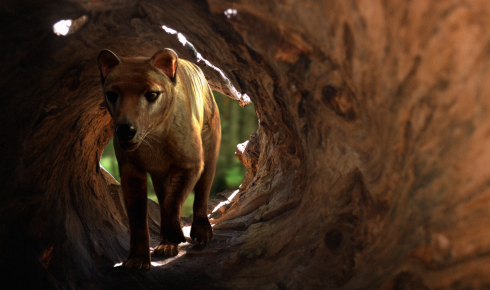 The last captive Tasmanian tiger, or thylacine, died at Hobart Zoo in 1936. (Illustration courtesy of Colossal)
The last captive Tasmanian tiger, or thylacine, died at Hobart Zoo in 1936. (Illustration courtesy of Colossal)
So we can imagine that the dodo, a large frugivorous ground dwelling bird, had a similar impact on the ecosystem – and something that can replace it might have a similar effect. The Tasmanian tiger (thylacine) was the top predator in its ecosystem. If a new top predator could be reintroduced, it could restore some of the missing ecological interactions and have cascading benefits to the ecosystem.
Just the idea of having these species back is already having an impact. The Mauritian Wildlife Foundation has seen a renewed investment in trying to find new places in Mauritius where dodos might someday be released.
What about the mammoth? If you have them roaming around at scale, what effects will we see on those northern regions?
It's hard to predict. Elephants are engineers of their ecosystem, and you can imagine that a mammoth would have played a similar role. In the tundra during the Pleistocene, there were bison and horses in North America, moose in Asia, woolly rhinos and all sorts of megafauna that would have knocked down larger bushes and trees and redistributed nutrients. I think the biggest benefits we might see is them consuming resources, then moving those nutrients around the landscape, churning soil and reinvigorating floral communities that have been missing since the extinction of these megafaunal communities.
Colossal tends to announce its work and major breakthroughs through press releases and media interviews, but it's really hard to find data on the individual scientific workstreams for relevant scientific communities to scrutinise. Would you accept that it's not a great way to build trust and consensus around de-extinction among the more traditional academic community?
I was an academic until six months ago, and what I'm trying to do as the chief science officer is bring the balance to that. I do think that it's important that we publish the work that we're doing. When we managed to create induced pluripotent stem cells from elephants it was published in a preprint on bioRxiv. It's currently in peer review at a journal, so we are going to publish it with all the details that are there.
As we have further progress that's worth publishing, we will do that, with the understanding that we're probably under more scrutiny than a standard academic lab would be. But at the same time, to keep people interested and keep investors motivated, we have to keep saying “this is what we're doing, isn't it cool, and isn't it worthwhile?”. It's important to have both.
Let’s talk about timelines – we’ve been hearing from various groups since 2011 that the birth of the first resurrected woolly mammoth is just around the corner…it’s another reason people are sceptical about this type of project.
It's George Church [the Harvard geneticist and co-founder of Colossal]! Every time he says there’s going to be a mammoth in X number of years, somebody from Radio 4 calls me and says ‘can you immediately go on the air and talk about this?!’
The only timeline that was announced from Colossal was in the very beginning, when George announced the mammoth timeline. I wish that I could predict the pace of scientific discovery, but if we tell the media a particular date we're going to be held to that date, and what we're doing is hard.
We're trying to solve many of the hardest problems in biology simultaneously. And I want the scientists on my team to be able to be careful and curious and thoughtful in their work, and not just panicked because of some arbitrary deadline imposed.
There are different technical challenges to each of these projects. An artificial womb is a big technical challenge and the first mammoths probably won’t be born from an artificial womb. But with a bird, as soon as we can solve how to keep primordial germ cells alive in a dish, eggs are a lot easier than trying to breed something in a surrogate host.
I'm not going to say it’s simple, because it's not. I think we’re really close to a breakthrough on primordial germ cells (PGCs) with dodos. We now have PGCs that can live for up to three weeks, and that's almost enough for us to grow enough of them to be able to edit.
As soon as we get there, the dodo might be pushed up the timeline faster than something else. But if it takes us longer to get there, maybe it'll be the marsupial, because for that, we only have to have an artificial womb that can keep an embryo alive for 12.5 days until we can transfer it to the pouch of a larger marsupial.
Can we finish by you painting us a picture of what you hope Colossal can achieve in the long term, over decades.
I'm really happy about the foundation launch yesterday. To me, it’s what's really most important about this. I think if we want a future that is both filled with people and biodiverse, we have to be able to develop these tools and apply them to real biodiversity conservation for species that are alive today. I'm excited that we have these tools and the future – whether it's 20 or 50 years from now – will have our mammoths and our dodos and our thylacines, but more importantly, it will also have woolly rhinos, pink pigeons, vaquitas and Hawaiian honeycreepers – and all the species we're in danger of losing today.
Find out more at Colossal.com
Professor Beth Shapiro is an evolutionary molecular biologist specialising in ancient DNA and chief scientist at the de-extinction start-up Colossal Biosciences


